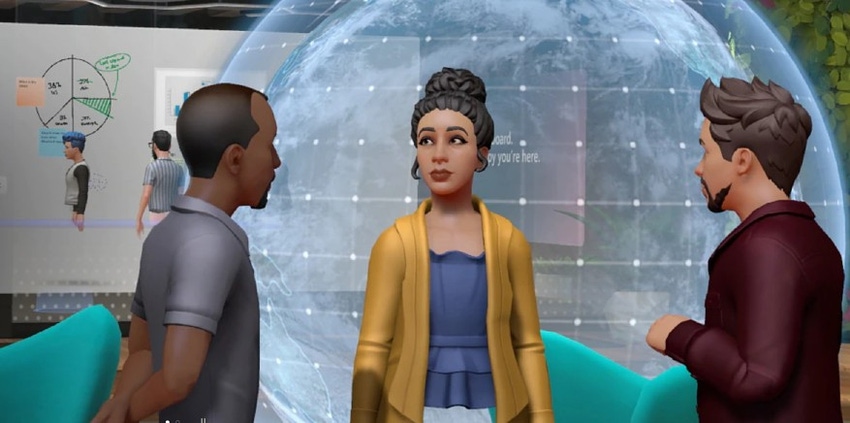Microsoft Previews Mesh for Teams as ‘Gateway’ to Mixed-Reality Metaverses
Mesh for Teams promises to create more immersive meetings.
November 3, 2021

Microsoft is joining the “metaverse” bandwagon with Mesh for Teams. The technology, previewed this week at the fall Microsoft Ignite virtual conference, aims to make Teams a “gateway” to metaverses.
The metaverse concept, consisting of digital avatars and mixed reality to computing experiences, gained further awareness from Facebook last week. The social networking behemoth said it is staking its future on the metaverse by changing its corporate name to Meta.
For its part, Microsoft has emphasized mixed reality for many years, and there are some large implementations of its HoloLens. During its spring Ignite event, Microsoft signaled that mixed reality is ready for more pervasive use in work environments when it previewed Mesh.
Microsoft is now emphasizing a commercially viable view of the metaverse concept with a focus on productivity, collaboration and meetings. The pandemic and advances in video meeting capabilities have made remote work feasible as a permanent way of working. However, nearly two years into the pandemic, many feel video meetings can be static and tend to leave participants out.
Mesh for Teams seeks to address this by bringing holographic, mixed-reality capabilities to Teams. The new feature makes meetings consisting of a combination of remote attendees and people in the office more immersive. For example, people in different locations can share holograms and simulations in Microsoft Teams meetings, chats and when sharing documents.
When first using Mesh for Teams, users will create custom avatars that could be a still image or a video. Then they can access metaverses or immersive spaces built by organizations or partners.
Mesh for Teams will include pre-built, immersive spaces for functions such as meetings to social mixers. Organizations will be able to build custom immersive spaces. Over time, Mesh for Teams will offer more immersive capabilities, with improvements in the sensor technology embedded into virtual reality headsets and other devices.
Microsoft’s Metaverse Ambitions
Microsoft chairman and CEO Satya Nadella has ambitious plans for bringing metaverse experiences to Teams and other collaborative activities.

Microsoft’s Satya Nadella
“Mesh for Microsoft Teams will allow you to connect with presence and have a shared immersive experience directly in Teams,” Nadella said during the Ignite keynote session.
“When we talk about the metaverse, we’re describing both a new platform and a new application type, similar to how we talked about the web and websites in the early 90s,” Nadella said. “In a sense, the metaverse enables us to embed computing into the real world, and to embed the real world into computing, bringing real presence to any digital space.”
Mesh for Microsoft Teams is set to start rolling out during the first half of 2022. Nadella signaled it is suited for pervasive use. “I can’t overstate how much of a breakthrough this is,” Nadella said. “For years, we’ve talked about creating this digital representation of the world. But now we actually have the opportunity to go into that world and participate in it.”
Accenture Deployment
Accenture, Microsoft’s largest partner, was one of the first to deploy Teams to hundreds of thousands of employees. The global systems integrator had early access to Mesh for Teams. Accenture has used it to create a virtual campus, virtual meeting rooms and virtual reality-based collaborative experiences. Ellyn Shook, Accenture’s chief leadership and HR officer, discussed how the company is using Mesh during the Microsoft Ignite keynote.
“It’s so important to bring the human connection into our digital world,” Shook said. “We’re using this technology for meetings and learning, team get-togethers, and it’s helped us really transform our new joiner experience.”
Many employees prefer using avatars in meetings rather than appearing on camera all day, she explained.
“We love this new feature because it gives everyone the flexibility and choice to show up in ways, they are most comfortable,” Shook said. “And for me not having to be on camera all day has really helped with my energy and engagement.”
Want to contact the author directly about this story? Have ideas for a follow-up article? Email Jeffrey Schwartz or connect with him on LinkedIn. |
About the Author(s)
You May Also Like


